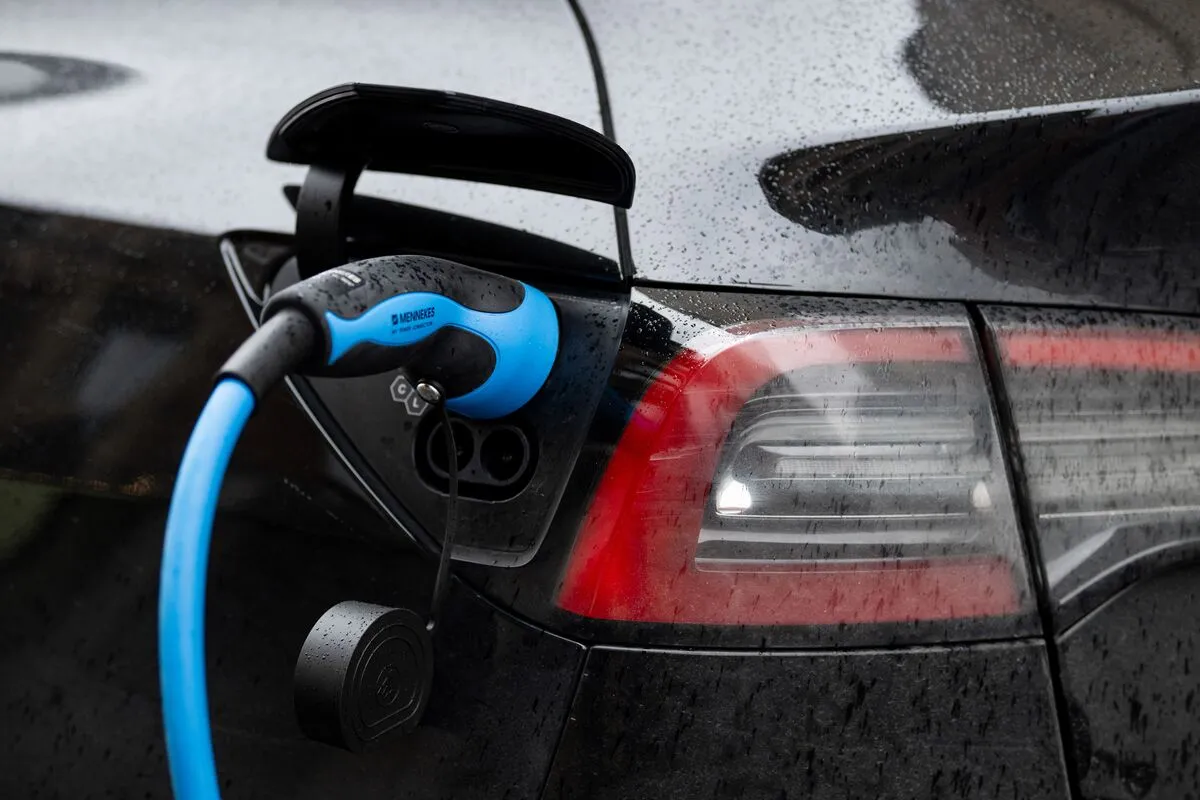
Remember that this was removed at the request of a industry group that strongly recommends all new homes have natural gas lines run to all appliances just in case some future homeowner might want them.

I got a $5,000 estimate to get mine installed. Luckily we knew a guy who only requested beer and to not clean up the drywall

Letting a guy run a 240V line from a panel that might not be able to handle it for the price of a beer? You like to live dangerously.

More backstory they are an electrician and he has installed several chargers already. They were not intoxicated during the process, least as far as I can tell for drinking 2 bud lites for an hour+ of work

Coming as someone who did the same themselves, basically all mains wiring is good up to 600v in the US, and all main and sub panels have breakers precisely because you can overload them just by using a decent portion of your circuits to their fullest.
Putting in new circuits or plugs isn’t exactly uncommon or particularly difficult. The biggest thing to watch out for being the extra 20% safety margin the NEC requires on top of a circuits rated capacity that if I remember correctly puts you a gauge up from what the circuit itself requires, but if the state certified inspector signed off on it then it’s almost certainly good to go.

Second this.
I’ll fuck around a little with 120. I will NOT fuck around with 240. I had an electrician install the wiring for my induction range.

There’s no difference between two 20A 120V circuit and one 40A 240V circuit. Two 12/2 vs one 10/3. Two breaker slots vs 1. Each conductor in the 240V circuit is the same volts as the hot of the 120V circuit. All fire risks and such are essentially identical.
You should not do home repair beyond your comfort zone, especially electrical. That said, there’s nothing particularly spooky going on here.

Wiring up 240V circuits with 60A fuses was literally something many British and Irish kids did before their teens before the 90s. You had to wire plugs for every new item you bought as they were sold separately. Plugs has 13A fuses, so current was more limited… Unless you wired it wrong…

The new home I purchased has a gas stove. Instead of replacing it, we’re planning to just buy a portable (pluggable) 1-plate induction cooktop as our primary cooking station, and use the gas stove for prolonged cooking like boiling rice/pasta or pressure cooking. It shouldn’t be an issue to plug the induction cooktp into one of the outlets in the kitchen right?

Get an electric kettle, too. Boiling water on either a gas range or a standalone 110V induction hob is pretty slow, but can be jumpstarted in an electric kettle to spare a lot of headache.
As someone who cooks a lot, gas ranges just plain suck to use. Don’t believe the astroturf. They take 20x more work to keep clean (which is honestly the only reason I need to hate them). They also heat pans super slowly (even my previous cheapo ceramic resistive electric range, which had a 5000W hob, heated pans faster than any gas range I’ve ever used), they irritate your eyes and fuck with your air quality (and thus require much more powerful vent hoods – which are loud and also suck your climate controlled out), and they rapidly heat up the room you use them in.
Buy commercial if the hob is going to be your workhorse, though. The commercial ones are just built to a way higher standard compared to the cheapo import brands. They cost more and are ugly, but they will last you way longer. They tend to have things like powerful cooling fans – which can be a bit noisy, but it protects their electronics.
I can’t speak for your local energy prices, but I’d be surprised if the gas is so much cheaper than electric that it is worth using the gas range for things that are going to be powered for a long time.
Though they aren’t readily-available yet, there’s a new product category starting to appear that’s more renter-friendly for this – electric ranges with built-in batteries that run off regular 110VAC power. The prices are high, since you are also paying for a relatively large backup battery (that can run things like your fridge during a blackout, for example), but for many they are cheaper than the cost to have a 14/3 40A line run to the kitchen by an electrician.

Do you mean Natural Gas or propane?
Because as someone who does a lot of cooking, I will pick gas every day of the week.
Especially for my wok, electric stoves never get them hot enough.

Yeah, I hear people say this all the time. And maybe before I actually was forced to use electric for a year or two, I also would’ve said the same. But no, I would never go back at this point. The electric experience is plain better. Literally the only downside is you have to use the broiler to char a pepper or warm a tortilla rather than doing it directly on the fire, and that’s hardly a sacrifice – the broiler does a better job evenly charring stuff anyway.
Highly encourage you to try a dedicated induction wok burner appliance. The type with a concave base. They’re wildly more popular in wok-loving parts of the world for home cooking over gas for good reason.
You aren’t getting wok hei with a gas range, period. They also simply cannot get the wok hot enough, and they distribute the heat in a crown midway up the pan instead of in the bottom where it belongs. Using a wok on a traditional gas range is just an over-complicated saute pan. And I agree, no typical electric range can do it either. Nothing gets a pan hotter than induction, but a typical induction range doesn’t interface properly with a wok to make it happen. Only a dedicated wok cooker does the job. That means either one of those insane commercial jet engine 120k BTU cookers like they have in the serious wok restaurants, a backyard stovepipe-style coal wok cooker, or a dedicated wok appliance.
Better, they aren’t that expensive. If you really enjoy using a wok, one of them will change your life. They actually apply the heat the correct way: extreme heat concentrated in the bottom of the pan.

I just modified my forge burner to use it.
Hot enough to weld steel is more than hot enough to make a good stir fry.
Annoying when it rains though

So the truth is, it’s not even a gas range you care about. It’s a completely different specialty appliance. Which kind of goes back to my point that electric ranges are flat better than gas ranges – you, a self-avowed gas-lover, still needed to design a custom appliance to cook the way you wanted to because your gas range couldn’t do it.
And that’s the short of it. Electric ranges are hugely easier to clean, have better temperature stability, heat pans hotter and do it faster, and don’t heat the room or fuck with air quality. And that’s not even getting into the unequivocal superiority of electric ovens over gas ones.
Still, you should try an induction wok hob if you get the chance. Sounds a lot safer than your solution.

I don’t have a gas stove friend, I rent.
I had no option but to rig one up. lol
I still disagree with you about gas stoves, I much prefer them and their instant response.
I might just not have had a good electric range yet.
I do have an induction hot plate though and it is infinitely better than my 220v stove, other than needing special pans.
At the end of the day, what I care about most is not telling people what they have to do though.
Edit: there to their

Get an electric kettle, too
Yup, we definitely will. We also used to have one.
Buy commercial if the hob is going to be your workhorse
I’ll definitely shop around.
but I’d be surprised if the gas is so much cheaper than electric that it is worth using the gas range for things that are going to be powered for a long time
I actually have to compare once we move in. The house has solar panels, so I need to test if it would be cheaper overall to use induction vs the gas stove, or use both depending on the type of cooking.

No issue. Those are specifically made for a standard outlet. They are just less powerful than a full induction stove top that’s hooked up to a 240V line.

Thanks, that’s a good point. I used to live in a country that uses 220V as standard, so we could easily plug in stand-alone induction cooktops anywhere.

Right, assuming it’s made for that. But it won’t be anywhere near as powerful as a range. So it will work but not anywhere near as quickly.
My induction range required crazy thick wiring. 8 gauge, I think? Getting that done by an electrician cost more than the range itself.

It shouldn’t be an issue to plug the induction cooktup into one of the outlets in the kitchen right?
Just make sure it’s the only thing powered on that circuit, since an induction hotplate can easily pull 1500 watts at full power. You could also get a 220v to 110v adapter and use the stove outlet for the induction hotplate, which should give you an isolated 20A circuit.

If the kitchen was made for gas, it’s pretty unlikely there is a 220v outlet for an oven there.

You can’t say for sure. My house has a gas stove and a 220v outlet for an electric stove. Most houses are wired for an electric stove even if it has gas, because not everyone is going to want a gas stove and wiring an outlet is easier than running a gas line.

This is what I did. New induction stovetop for $5000 vs an induction cooktop for $50 that I can also take camping? Easy choice. We use the cooktop for a big toaster oven for everything, including pasta, so we only need to fire up the gas range if we absolutely need multiple burners or a ton of oven space.
Our cooktop heats up water just about as fast as our electric kettle, which was surprising to me. I guess they both probably pull the same amount of power from the wall.
Can’t recommend an induction cooktop enough. We got a Nuwave PIC, but I’m sure any cooktop will provide a similar great experience. If you end up getting a PIC, I recommend getting the case with it. We passed it up, but we’ve taken it camping a few times now and the case would have helped. It totally blows our camp stove out of the water.

Just sold my induction stove for 65 euro.

A prior resident of my house ditched the electric oven for a gas stove. So I’ve got the juice, and it’s on my list of appliances to replace… just not sure how to test the existing circuit without pulling the current stove to access the outlet. The breaker was off when we moved in, which could be precautionary. Or it could be why they replaced the stove to begin with.
Yeah, it’s tough to test an outlet like that if it’s blocked by a gas stove and you can’t remove it easily.

Here I am burning natural gas for several appliances in my home.

